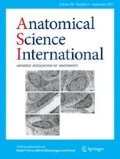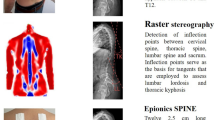Abstract
Several methods have been described to evaluate the degree of lumbar lordosis. However, suggested methods have used non-standardized terminology and landmarks to measure the degree of lumbar lordosis. In the present study a practical method for evaluating the degree of lumbar lordosis is described and, for this purpose, 24 lateral roentgenograms were obtained retrospectively from the archive of Department of Physical Medicine and Rehabilitation, Ondokuz Mayis University, Samsun, Turkey. The length between the superior and inferior angles of the first and fifth lumbar vertebral bodies, and the area behind the lumbar vertebral bodies, were estimated using the point counting and planimetry methods. A new unit, the projection area per length squared (PAL) was described on lateral roentgenograms. The planimetric approach was used as the gold standard in the present study. The point-counting method was also used to estimate the PAL and it was repeated three times to determine the variability of the technique. To evaluate the estimates’ accuracy, the results of point-counting were compared with those of the planimetry methods. The PAL changed by between 3.93 and 13.59% for the examined subjects. A high correlation was also noted between the results of the point-counting and planimetry methods (r = 0.997). It is concluded that the PAL approach could provide accurate and reproducible data for evaluating the degree of lumbar lordosis and low back pain.
Similar content being viewed by others
References
Amonoo-Kuofi HS (1992) Changes in the lumbosacral angle, sacral inclination and the curvature of the lumbar spine during aging. Acta Anat (Basel) 145, 373–7.
Barboriak DP, Padua AO, York GE, Macfall JR (2005) Creation of DICOM-aware applications using ImageJ. J Digit Imaging 18, 91–9.
Caillet R (1981) Low Back Pain Syndrome, 3rd edn. Davis, Philadelphia.
Chen YL (1999) Vertebral centroid measurement of lumbar lordosis compared with the Cobb technique. Spine 24, 1786–90.
Chernukha KV, Daffner RH, Reigel DH (1998) Lumbar lordosis measurement. A new method versus Cobb technique. Spine 23, 74–9.
Cortet B, Roches E, Logier R et al. (2002) Evaluation of spinal curvatures after a recent osteoporotic vertebral fracture. Joint Bone Spine 69, 201–8.
Gardocki RJ, Watkins RG, Williams LA (2002) Measurements of lumbopelvic lordosis using the pelvic radius technique as it correlates with sagittal spinal balance and sacral translation. Spine J 2, 421–9.
George SZ, Hicks GE, Nevitt MA, Cauley JA, Vogt MT (2003) The relationship between lumbar lordosis and radiologic variables and lumbar lordosis and clinical variables in elderly, African-American women. J Spinal Disord Tech 16, 200–6.
Grochowsky JC, Alaways LW, Siskey R, Most E, Kurtz SM (2006) Digital photogrammetry for quantitative wear analysis of retrieved TKA components. J Biomed Mater Res B Appl Biomater 79, 263–7.
Gundersen HJG, Boysen M, Reith A (1981) Comparison of semiautomatic digitizer-tablet and simple point counting performance in morphometry. Virchows Arch B Cell Pathol Incl Mol Pathol 37, 317–25.
Harrison DE, Harrison DD, Cailliet R et al. (2001) Radiographic analysis of lumbar lordosis, centroid, Cobb, TRALL, and Harrison posterior tangent methods. Spine 26, E235–42.
Hicks GE, George SZ, Nevitt MA, Cauley JA, Vogt MT (2006) Measurement of lumbar lordosis, inter-rater reliability, minimum detectable change and longitudinal variation. J Spinal Disord Tech 19, 501–6.
Jackson RP, Hales C (2000) Congruent spinopelvic alignment on standing lateral radiographs of adult volunteers. Spine 25, 2808–15.
Jackson RP, McManus AC (1994) Radiographic analysis of sagittal plane alignment and balance in standing volunteers and patients with low back pain matched for age, sex, and size. A prospective controlled clinical study. Spine 19, 1611–18.
Mathieu O, Cruz-Orive LM, Hoppeler H, Weibel ER (1981) Measuring error and sampling variation in stereology, comparison of the efficiency of various methods of planar image analysis. J Microsc 121, 75–88.
Polly Jr DW, Kilkelly FX, McHale KA, Asplund LM, Mulligan M, Chang AS (1996) Measurement of lumbar lordosis. Evalua- tion of intraobserver, interobserver, and technique variability. Spine 21, 1530–5.
Sahin B, Ergur H (2006) Assessment of the optimum section thickness for the estimation of liver volume using magnetic resonance images, a stereological gold standard study. Eur J Radiol 57, 96–101.
Sahin B, Aslan H, Unal B et al. (2001) Brain volumes of the lamb, rat and bird do not show hemispheric asymmetry, a stereological study. Image Anal Stereol 20, 9–13.
Sahin B, Emirzeoglu M, Uzun A et al. (2003) Unbiased estimation of the liver volume by the Cavalieri principle using magnetic resonance images. Eur J Radiol 47, 164–70.
Schuler TC, Subach BR, Branch CL et al. (2004) Lumbar Spine Study. Segmental lumbar lordosis, manual versus computerassisted measurement using seven different techniques. J Spinal Disord Tech 17, 372–9.
Shea KG, Stevens PM, Nelson M, Smith JT, Masters KS, Yandow S (1998) A comparison of manual versus computerassisted radiographic measurement. Intraobserver measurement variability for Cobb angles. Spine 23, 551–5.
Vialle R, Levassor N, Rillardon L, Templier A, Skalli W, Guigui P (2005) Radiographic analysis of the sagittal alignment and balance of the spine in asymptomatic subjects. J Bone Joint Surg Am 87, 260–7.
Author information
Authors and Affiliations
Corresponding author
Rights and permissions
About this article
Cite this article
Kuru, O., Sahin, B. & Kaplan, S. Alternative approach to evaluating lumbar lordosis on direct roentgenograms: projection area per length squared. Anato Sci Int 83, 83–88 (2008). https://doi.org/10.1111/j.1447-073X.2007.00210.x
Received:
Accepted:
Issue Date:
DOI: https://doi.org/10.1111/j.1447-073X.2007.00210.x




